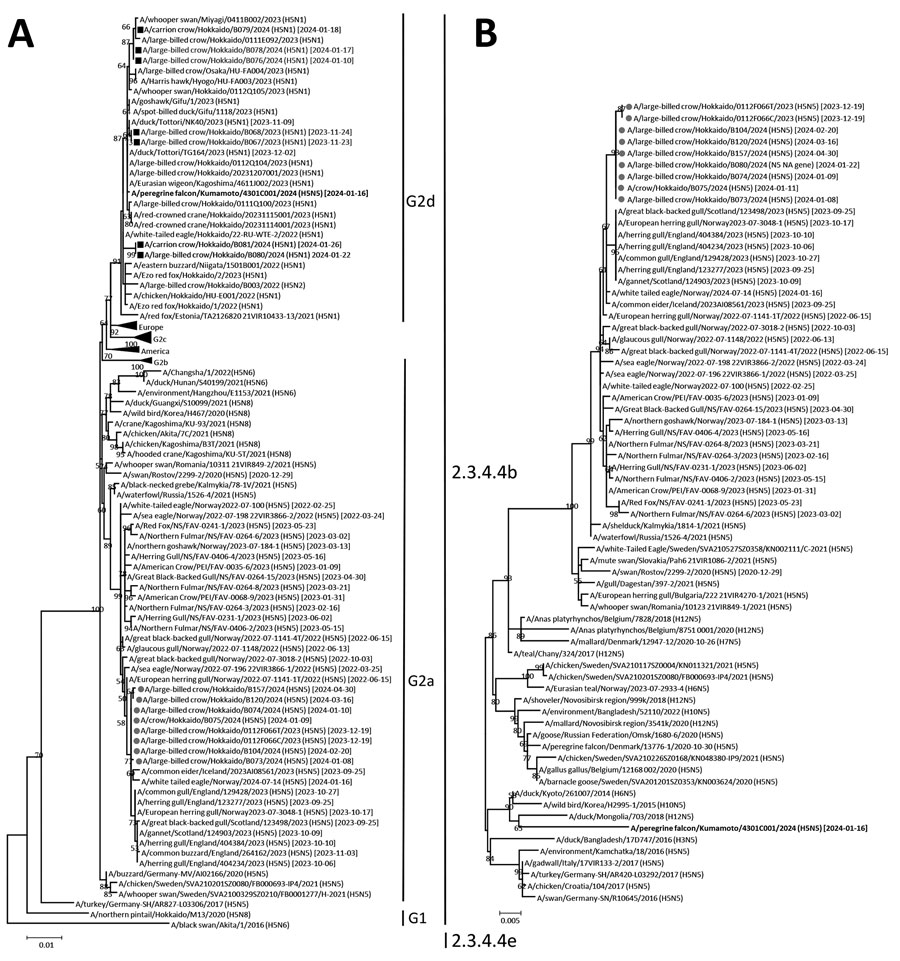Cocirculation of Genetically Distinct Highly Pathogenic Avian Influenza H5N5 and H5N1 Viruses in Crows, Hokkaido, Japan
Yik Lim Hew, Takahiro Hiono

, Isabella Monne, Kei Nabeshima, Saki Sakuma, Asuka Kumagai, Shunya Okamura, Kosuke Soda, Hiroshi Ito, Mana Esaki, Kosuke Okuya, Makoto Ozawa, Toshiyo Yabuta, Hiroki Takakuwa, Linh Bao Nguyen, Norikazu Isoda, Kohtaro Miyazawa, Manabu Onuma, and Yoshihiro Sakoda
Author affiliations: Hokkaido University, Sapporo, Japan (Y.L. Hew, T. Hiono, L.B. Nguyen, N. Isoda, Y. Sakoda); Istituto Zooprofilattico Sperimentale delle Venezie, Padova, Italy (I. Monne); National Institute for Environmental Studies, Tsukuba, Japan (K. Nabeshima, M. Onuma); National Agriculture and Food Research Organization, Tsukuba (S. Sakuma, A. Kumagai, K. Miyazawa); Tottori University, Tottori, Japan (S. Okamura, K. Soda, H. Ito); Kagoshima University, Kagoshima, Japan (M. Esaki, K. Okuya, M. Ozawa); Kyoto Sangyo University, Kyoto, Japan (T. Yabuta, H. Takakuwa)
Main Article
Figure

Figure. Phylogenetic analysis of genetically distinct highly pathogenic avian influenza H5N5 and H5N1 viruses isolated in Japan in winter 2023–24. H5 hemagglutinin (A) and N5 neuraminidase (B) gene segments of H5N5 highly pathogenic avian influenza viruses (HPAIVs) isolated in winter 2023–24 were compared with reference strains within clade 2.3.4.4b obtained from GISAID (https://www.gisaid.org). Squares indicate H5N1 and circles indicate H5N5 HPAIVs isolated from crows in Hokkaido in winter 2023–24. Bold text indicates the H5N5 HPAIV isolated from a peregrine falcon in Kumamato in the southern part of Japan in winter 2023–24. Trees were constructed by using the maximum-likelihood method and MEGA 7 software (https://www.megasoftware.net). Bootstrap values (>50%) from 1,000 replicates are indicated on nodes. Isolated viruses belonging to subgroups G1, G2a, and G2d and clade 2.3.4.4b are indicated. Dates after strain names indicate sample collection dates for HPAIV-infected animals. Scale bar indicates number of nucleotide substitutions per site.
Main Article
Page created: July 08, 2024
Page updated: August 21, 2024
Page reviewed: August 21, 2024
The conclusions, findings, and opinions expressed by authors contributing to this journal do not necessarily reflect the official position of the U.S. Department of Health and Human Services, the Public Health Service, the Centers for Disease Control and Prevention, or the authors' affiliated institutions. Use of trade names is for identification only and does not imply endorsement by any of the groups named above.
